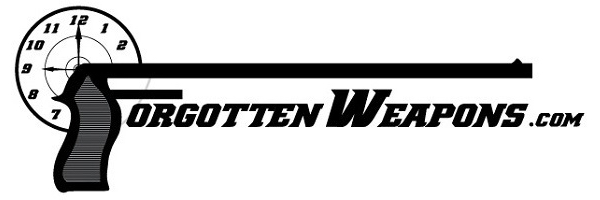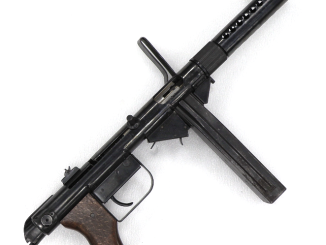Despite being a neutral power during World War Two, Sweden had a variety of very interesting small arms – like their dual-mount Browning m/36 machine guns. These were originally adopted because the Swedes wanted a heavier medium MG cartridge and didn’t think their delayed-blowback Schwarzlose guns could handle it. The cartridge was 8x63mm, pushing a 219 grain projectile at 2500 fps. The m/36 Browning was a water cooled gun, an improvement on the older M1917 design. It not only handled the powerful new round, but it could also be easily swapped to the older 6.5x55mm round to use stocks of existing ammunition (and it would be later adapted to 7.62mm NATO as well). Most of the guns were built as matching pairs for antiaircraft use, with mirrors left and right side feeds and in effective recoil-absorbing cradle mounts.
Special thanks to Bear Arms in Scottsdale, AZ for providing access to this rare pair of guns for today’s video!



could you do something on the kropatschek and its variations
This system was already covered see https://www.forgottenweapons.com/french-1878-marine-kropatschek/
“(…)handled the powerful new round,(…)”
This should not be surprised considering that it was specifically designed to fit into said fire-arm (observe that 7,62×63 and 8×63 have not only similar case lengths, but also overall lengths).
“(…)with Brownings and Maxims and Vicers guns, all the guns that have water jackets and hoses like this, do they circulate the water? And the answer is no.(…)”
In most cases it so, but Зенитная пулемётная установка М4 образца 1931 года did so, by using hand operated pump, see 4th image from top at https://www.voentex.ru/blog/32
“(…)mirrors left and right(…)”
It is interesting that they do so, whilst Belgian, when needed to do feed from another side, decided to make switchable one, see https://www.airwar.ru/image/idop/weapon/fn30/fn30-13.jpg upper half is single-side infantry, lower half is switchable aviation machine gun
Photo from top https://www.airwar.ru/weapon/guns/fn30.html
I absolutely love the cartridge; the guns are a bit big and aren’t true GPMG-configured, but I think they’d be a lot better base of development for a true support MG package than anything in the half-ass wannabe individual weapon cartridges like 7.62 NATO.
I still say that a somewhat downloaded 6.5 Swedish cartridge in the individual weapon space, and this in the support MG space…? That absolutely would have been the way to go, in terms of actual combat utility and effectiveness for the latter half of the 20th Century. Hell, the first half, as well…
Re the water recirculation idea, I have read somewhere that the LRDG in North Africa connected their water-cooled Vickers guns into the cooling systems of their vehicles so that they could use their vehicle engines to cool the guns. So the water would be recirculated.
I heard something along those lines, or read it somewhere, coupled with the apocryphal account that they used to heat the water for their tea with the guns…
I know that the water quality standards weren’t all that good for the North Africa campaign, but that struck me as particularly unlikely, given the realities of it all. On the other hand, I wasn’t there, and I don’t know the facts. Maybe they did, maybe they didn’t…
I wish I could remember where that account was reported, but I can’t. I just remember reading or hearing it from somewhere.
One thing that does strike me, from this point in my life, having had experience of living and training in the desert, is that connecting the two systems (engine and gun cooling, both) you’re drastically increasing the potential points of failure for two critical systems on the vehicle. Additionally, you’re adding in the hazard created by the tubing or hose you use to connect them, and… Well, I just don’t know: If it was me, I’d be like “Oh, hell no…”
There are good reasons we don’t do water cooling any more. The plumbing and the vulnerability of the plumbing are probably some of the main ones…
“(…)If it was me, I’d be like “Oh, hell no…”(…)”
Then you might be glad that you did not have to work inside COVENANTER https://www.worldwarphotos.info/gallery/uk/british-tanks/covenanter which so arranged that piping between frontally placed radiator and rear mounted engine served the dual purpose of cooling the engine and roasting the crew
British tank design, with the sole exception of the Centurion, is a litany of horror for all concerned.
There are enough objective causes of complaint to literally write shelves full of books on the various and sundry issues. The Germans and Soviets rightly laughed their asses off during most of their evaluations of captured/(whatever the Brits called their Lend-Lease program to the Soviets).
The only British Lend-Lease tank the Soviets liked was the Valentine VI with the 6-pounder (57mm) gun. Most of the ones they got were built in Canada and shipped by CP rail to Alaska, across the Bering Strait and then on the trans-Siberian railway. They never came even close to Britain.
Why did they like the Val?
First, it was a lot more mechanically reliable than most British tanks. It was designed by Vickers-Armstrong and built by Ford Canada.
Second, its 57mm gun could be bored out to take Russian 76.2mm tank gun ammunition, same as on the T34. (The British had already done this trick on the 6-pounder on Cromwell, boring it out to take American 75mm ammo.) The up-calibering of the gun changed the Val 6 from a reliable little scout tank to a reliable little tank destroyer.
Ironically, the only use the British Army could think of for the Val 6 was as a turretless gun tractor.
clear ether
eon
I have never heard that anecdote, and I thought I knew most of the trivia about WWII tanks and weapons in Soviet hands.
It strikes me as questionable on the face of it… Either the British gun tube was seriously overbuilt for its caliber, or the Soviet artillery round was drastically underpowered, in order for that to work. I mean, that’s just under 20mm of material removed from those barrels, along with whatever they had to do in the chamber areas. That’s a lot of metal; I hear that and I’m going “WTF? Seriously? I’ve seen British 57mm guns from WWII, and I’m not sure they have 20mm of material to remove…”
Which isn’t to say that I think it’s impossible or that you’re repeating bogus stuff, but… Man, I’d love to see some citations. That is just patently hard to believe. Yeah; bore it out to 65mm or something? But 76.2? That’s massive, and unless the 57mm guns I saw were different beasts, then I cannot see how such a feat could be achieved without creating barrel walls that were paper-thin.
Now, I could easily believe that they re-barreled those guns entirely… The breech assemblies on those 57mm guns that I saw were fairly overbuilt, to the point where I wondered why they didn’t. I think I read somewhere that the basic assembly was adapted into one of the bigger British AT guns with minimal dimensional changes.
Boring out? Man, I just don’t know.
@ Kirk;
The 6-pounder tank gun’s tube was first designed for Crusader III, and if you look at one of those it has almost no taper and is close to the OD of our 105mm howitzer tube. Very different from the fairly skinny tube of the 57mm AT gun.
The same gun was used on Cromwell and Val 6, and the Russian 76.2mm cartridge case (they had only one case for all guns in a given bore spec, regardless of application) was a straight-wall, slightly tapered one about the same size as the U.S. 75mm case- which of course was nothing more than the WW1 French M1897 75mm field gun cartridge.
In terms of breech pressure and etc., the Russian 76.2 was in the same range as the French/American 75. That was why they developed the 85mm from an AA gun for T34/85; the “3-incher” wasn’t getting through the glacis of the later German PzKw IVG/H, let alone the Panther.
So yeah, if the British could bore out Crusader/Cromwell’s overbuilt 57mm to French/U.S. 75mm, I can believe the Russians could do the same in 76.2 on the same overbuilt gun on the Valentine VI.
BTW, in 1943 the British tried to mount the 17-pounder on Crusader, same as they did on Sherman Firefly. It didn’t work. That mistake was named…Challenger.
Yes, the modern 120mm “CHARMed” Challenger I and Challenger II (both basically gussied-up Chieftains that actually went to war with nearly shot-out Chieftain 120s) should really have been Challenger II and III, respectively.
And they were no more successful than the first one, in the best – or worst- tradition of British tank design other than Centurion.
Which seems to be the only one they ever got more-or-less completely right.
cheers
eon
No 6pdr armed Valentines were converted to Soviet 76mm, they used original gun.
Two improvements that were made were that their own 57mm HE was adopted (later Brits also started supplying their HE) and 2″ smoke mortar was slightly adopted to fire Soviet 50mm HE rounds from their 1938/1940 company mortar. Some later got uparmor, additional 30mm on front hull and partially on the upper sides.
I’ve read a number of accounts of reheating or keeping coffee or tea warm on the breech of a gun after a battle. I wonder if a game of telephone from that led to the “water jacket as teakettle” thing.
“Heat the water for their tea with the guns…” Tea was quite important to Britain… Could have been an intentional design.
Do the Swedes drink tea? I mean that looks like it would be a great kettle; cold up there… Missed the bi-Plane? Have a brew. Try again in a bit.